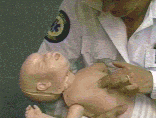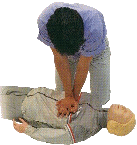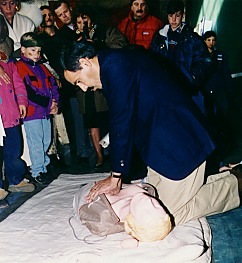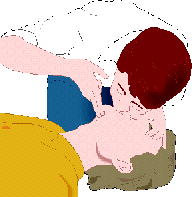 |
 |
 |
 |

La cadena de la Supervivencia

1. El acceso temprano.
El sistema médico de emergencia tiene que ser activado inmediatamente
para reducir el tiempo de respuesta.
 2. RCP temprano.
2. RCP temprano.
El RCP iniciado inmediatamente, en un plazo de 1 a 4 minutos, mantiene la
oxigenación de órganos vitales, como el cerebro y el corazón.
Estos es esencial para que la posterior desfibrilación y que los
medicamentos sean efectivos.
3. Desfibrilación temprana.
Si la víctima recibe RCP dentro de los 4 minutos y la desfibrilación
en un plazo de 8 a 12 minutos, hay una chance significativa de
supervivencia.
El uso sistematizado de desfibriladores hace posible que más gente
sea entrenada y preparada para la respuesta a emergencias cardiacas.
4. Rápido Apoyo de Vida Cardíaco Avanzado.
El tratamiento definitivo, como la administración de medicamentos
y el mantenimiento de la vía aérea, aumenta la oportunidad de supervivencia.
LA RESUCITACION EN EL HOGAR PUEDE AUMENTAR LA SOBREVIDA AL PARO CARDIACO
Los eventos de muerte por paro cardíaco podrían reducirse si se optimiza la resucitación en el hogar.
Maastricht, Países Bajos
Debido a la alta incidencia de pacientes que sufren paro cardíaco en el hogar luego de un infarto de miocardio, es necesario optimizar la práctica de resucitación cardiopulmonar fuera del hospital.
[Journal of the American College of Cardiology 30:1500-5; 1997 - SNC]
CPR SHOULD BE ADMINISTERED BY A TRAINED PERSON.
For CPR to work, victim should be lying flat on a firm surface with head at the same level as heart.
 When you take a CPR or First Aid Course you will learn not only how to check
for the ABC's but how to perform CPR on adult, child and infant. CPR is
administered when the person's ABC's are not present. CPR techniques are
different for different ages.
When you take a CPR or First Aid Course you will learn not only how to check
for the ABC's but how to perform CPR on adult, child and infant. CPR is
administered when the person's ABC's are not present. CPR techniques are
different for different ages.
Practice on manikins is important when learning CRP. They should NEVER be practiced on a live person or animal. Furthermore techniques & skills can change as a result of research and clinical studies.
When taking a CPR course you also learn to care for CHOKING victims. This skill is also different for ages & situations-is the victim conscious or unconscious.
As you can see CPR and care for the choking victim require skills that need to be carefully learned, practiced and always refreshed.
CAUTION ABOUT CHECKING THE ABC:
If a barrier device isn't available and you have any reservations about giving
rescue breathing or consider the victim at high risk for disease transmission,
the minimum you should do is:

Understand, however, that delaying mouth-to-mouth could mean death or disablity for the victim. Remember, proper function of the airway, breathing, and circulation are basic to life. Therefore, the ABC are always your first priority. Other illnesses and injuries are secondary.
Links:

